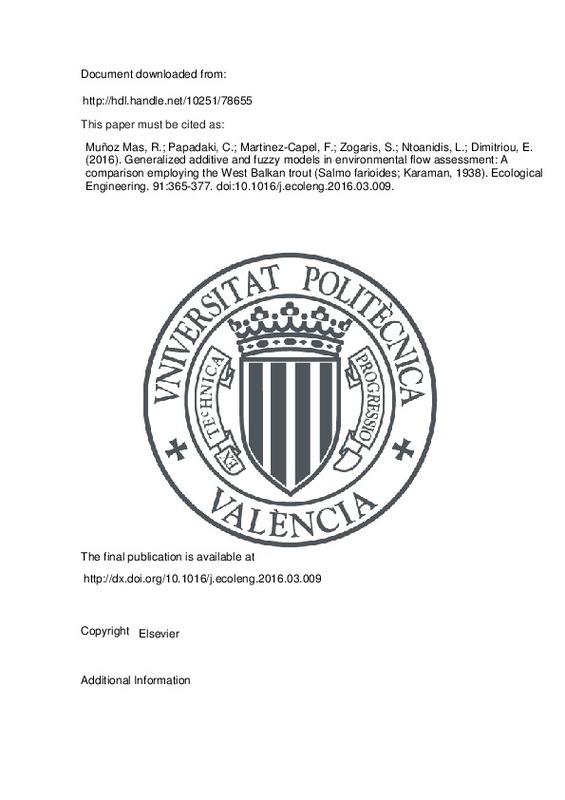JavaScript is disabled for your browser. Some features of this site may not work without it.
Buscar en RiuNet
Listar
Mi cuenta
Estadísticas
Ayuda RiuNet
Admin. UPV
Generalized additive and fuzzy models in environmental flow assessment: A comparison employing the West Balkan trout (Salmo farioides; Karaman, 1938)
Mostrar el registro sencillo del ítem
Ficheros en el ítem
| dc.contributor.author | Muñoz Mas, Rafael
|
es_ES |
| dc.contributor.author | Papadaki, Christina
|
es_ES |
| dc.contributor.author | Martinez-Capel, Francisco
|
es_ES |
| dc.contributor.author | Zogaris, Stamatis
|
es_ES |
| dc.contributor.author | Ntoanidis, Lazaros
|
es_ES |
| dc.contributor.author | Dimitriou, Elias
|
es_ES |
| dc.date.accessioned | 2017-03-10T15:43:40Z | |
| dc.date.available | 2017-03-10T15:43:40Z | |
| dc.date.issued | 2016-06 | |
| dc.identifier.issn | 0925-8574 | |
| dc.identifier.uri | http://hdl.handle.net/10251/78655 | |
| dc.description.abstract | Human activities have altered flow regimes resulting in increased pressures and threats on river biota. Physical habitat simulation has been established as a standard approach among the methods for Environmental Flow Assessment (EFA). Traditionally, in EFA, univariate habitat suitability curves have been used to evaluate the habitat suitability at the microhabitat scale whereas Generalized Additive Models (GAMs) and fuzzy logic are considered the most common multivariate approaches to do so. The assessment of the habitat suitability for three size classes of the West Balkan trout (Salmo farioides; Karaman, 1938) inferred with these multivariate approaches was compared at three different levels. First the modelled patterns of habitat selection were compared by developing partial dependence plots. Then, the habitat assessment was spatially explicitly compared by calculating the fuzzy kappa statistic and finally, the habitat quantity and quality was compared broadly and at relevant flows under a hypothetical flow regulation, based on the Weighted Usable Area (WUA) vs. flow curves. The GAMs were slightly more accurate and the WUA-flow curves demonstrated that they were more optimistic in the habitat assessment with larger areas assessed with low to intermediate suitability (0.2 0.6). Nevertheless, both approaches coincided in the habitat assessment (the optimal areas were spatially coincident) and in the modelled patterns of habitat selection; large trout selected microhabitats with low flow velocity, large depth, coarse substrate and abundant cover. Medium sized trout selected microhabitats with low flow velocity, middle-to-large depth, any kind of substrate but bedrock and some elements of cover. Finally small trout selected microhabitats with low flow velocity, small depth, and light cover only avoiding bedrock substrate. Furthermore, both approaches also rendered similar WUA-flow curves and coincided in the predicted increases and decreases of the WUA under the hypothetical flow regulation. Although on an equal footing, GAMs performed slightly better, they do not automatically account for variables interactions. Conversely, fuzzy models do so and can be easily modified by experts to include new insights or to cover a wider range of environmental conditions. Therefore, as a consequence of the agreement between both approaches, we would advocate for combinations of GAMs and fuzzy models in fish-based EFA. | es_ES |
| dc.description.sponsorship | This study was supported by the ECOFLOW project funded by the Hellenic General Secretariat of Research and Technology in the framework of the NSRF 2007-2013. We are grateful for field assistance of Dimitris Kommatas, Orfeas Triantafillou and Martin Palt and to Alcibiades N. Economou for assistance in discussions on trout biology and ecology. | en_EN |
| dc.language | Inglés | es_ES |
| dc.publisher | Elsevier | es_ES |
| dc.relation.ispartof | Ecological Engineering | es_ES |
| dc.rights | Reserva de todos los derechos | es_ES |
| dc.subject | Fuzzy kappa | es_ES |
| dc.subject | Habitat suitability | es_ES |
| dc.subject | Microhabitat | es_ES |
| dc.subject | Physical habitat simulation | es_ES |
| dc.subject | Salmo farioides | es_ES |
| dc.subject | Takagi-Sugeno-Kang fuzzy models | es_ES |
| dc.subject.classification | TECNOLOGIA DEL MEDIO AMBIENTE | es_ES |
| dc.title | Generalized additive and fuzzy models in environmental flow assessment: A comparison employing the West Balkan trout (Salmo farioides; Karaman, 1938) | es_ES |
| dc.type | Artículo | es_ES |
| dc.identifier.doi | 10.1016/j.ecoleng.2016.03.009 | |
| dc.relation.projectID | info:eu-repo/grantAgreement/ERMIS/GSRI//GR/Fish habitat use and ecological flows in Greece/ECOFLOW | es_ES |
| dc.rights.accessRights | Abierto | es_ES |
| dc.contributor.affiliation | Universitat Politècnica de València. Instituto de Investigación para la Gestión Integral de Zonas Costeras - Institut d'Investigació per a la Gestió Integral de Zones Costaneres | es_ES |
| dc.contributor.affiliation | Universitat Politècnica de València. Departamento de Ingeniería Hidráulica y Medio Ambiente - Departament d'Enginyeria Hidràulica i Medi Ambient | es_ES |
| dc.contributor.affiliation | Universitat Politècnica de València. Escuela Politécnica Superior de Gandia - Escola Politècnica Superior de Gandia | es_ES |
| dc.description.bibliographicCitation | Muñoz Mas, R.; Papadaki, C.; Martinez-Capel, F.; Zogaris, S.; Ntoanidis, L.; Dimitriou, E. (2016). Generalized additive and fuzzy models in environmental flow assessment: A comparison employing the West Balkan trout (Salmo farioides; Karaman, 1938). Ecological Engineering. 91:365-377. doi:10.1016/j.ecoleng.2016.03.009 | es_ES |
| dc.description.accrualMethod | S | es_ES |
| dc.relation.publisherversion | http://dx.doi.org/10.1016/j.ecoleng.2016.03.009 | es_ES |
| dc.description.upvformatpinicio | 365 | es_ES |
| dc.description.upvformatpfin | 377 | es_ES |
| dc.type.version | info:eu-repo/semantics/publishedVersion | es_ES |
| dc.description.volume | 91 | es_ES |
| dc.relation.senia | 321977 | es_ES |
| dc.contributor.funder | Ministry of Education, Lifelong Learning and Religious Affairs of the Hellenic Republic |







![[Cerrado]](/themes/UPV/images/candado.png)

